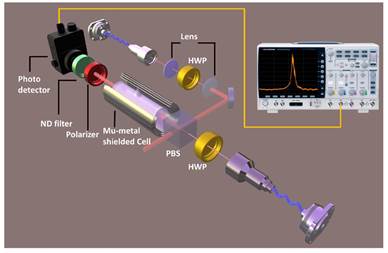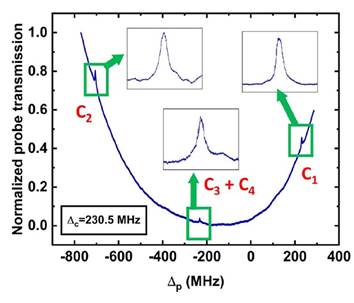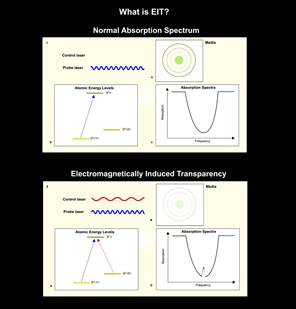Ministry of Science & Technology
Quantum Interferences in Atomic medium can store Light for High Precision Quantum Sensors
Posted On:
23 SEP 2024 3:17PM by PIB Delhi
Experimentalists have obtained a suitable optical response in an atomic medium that can be used to store light for a significant amount of time, facilitating designing applications for several quantum protocols for high precision quantum sensors, and more.
For several years now, scientists have been working with alkali atoms like Rubidium and Cesium, but there have been little efforts to deploy Potassium, for the sheer difficulty in working with this element.
Gourab Pal and Dr. Saptarishi Chaudhuri of the Quantum Mixtures (QuMix) lab at the Raman Research Institute, an autonomous institute of the Department of Science and Technology (DST), with their theory collaborator Prof. Subhasish Dutta Gupta, TIFR Hyderabad, used thermal Potassium and subjected the atoms to two laser lights in order to create quantum interferences in the atomic medium. The quantum coherence inside this atomic medium was created using the control light, which is also a laser. These probe and control lights were derived from extremely stabilized laser sources to perform the experiments using Potassium atoms.
“The innovative nature of this work lies in the use of Potassium atoms for performing Electromagnetically Induced Transparency (EIT) studies by coherent medium. We looked for the probe light response after it passed through an atomic coherent medium,” said Gourab Pal, PhD student and lead author of the paper titled ‘Velocity selective multiple two-photon dark and bright resonances in Potassium vapor’.
The EIT is a quantum interference phenomenon which dramatically modifies the optical response in atomic medium. In optical nonlinearities, there are multiple unique opportunities for controlling light with the use of light itself. And one classic example of this is EIT. This phenomenon occurs when the transmission of a probe beam is manipulated by the means of a control beam when passing through a dense medium. EIT experiments being scalable into the quantum domain with either one or more particles of light, the associated matter allows the implementation of quantum protocols with atoms and photons, as desired.
Observations following the experiments gave surprising results. Instead of observing just one resonance line shape, as has been the case with other alkali atoms, the QuMix experimentalists this time observed three-line shapes in a single absorption spectrum.
“This novel feature of three transparency windows using potassium vapours was observed for the first time. Usually, only one line shape is generally reported in previous works which deployed either Rubidium or Cesium atoms,” said Dr. Chaudhuri, co-author, and head, QuMix lab.
The latest paper published in Physica Scripta has further enhanced the overall current understanding on various types of quantum resonances in coherent atomic media.
“The additional two-line shapes emerged exclusively due to the closely-spaced, hyperfine ground states in potassium atoms. The two laser lights were found exchanging their excitation pathways using the moving atoms, creating two additional resonance lines. We have studied these experimentally with appropriate theoretical modeling,” explained Pal.
The photons of light beams are stored inside the atomic media. When the coherence is established in the atomic media, the light information is transferred from photons to atoms. After some time, this process reverts.
With India fast advancing its research and development efforts in the field of quantum technologies, RRI researchers said that this ability of storing light for a significant amount of time would come handy in multiple, futuristic quantum protocols, including quantum memory and quantum communication. A direct application of this understanding of coherent atomic media using Potassium would be in the domain of ultra-precise frequency stabilization of lasers.
Since line shapes are tuneable, in terms of position in the frequency domain, it is a perfect tool to stabilize laser frequency, especially where spectroscopic references are unavailable. This would avoid the need for using expensive wave-length meters, the researchers said.
The RRI duo claimed that the findings are unique because it corroborates that the quantum master equation (QME) description is valid even in cases where the ground energy level separation is small. QME is a theoretical tool to simulate quantum mechanical system (here Potassium atomic vapour), where light-matter interactions are studied. This approach is flexible to include various possible decay terms that mimic a real-world quantum system. In our theoretical modeling, we have used QME with relevant decay terms.
Research Paper link : https://iopscience.iop.org/article/10.1088/1402-4896/ad5b2c

Figure 1: A schematic of the experimental setup

Figure 2: Observation of three bright resonances for a given value of control beam detuning 230.5 MHz

Figure 3: Panel 1 shows the absorption spectrum of an atom under only the Probe light which has an energy similar to |F=1> to |F’>.
Panel 2 shows the absorption spectrum of an atom when along with the Probe light, a Control light (energy similar to |F=2> to |F’>) is also passed through it. C shows that at the absorption dip, a peak is seen, which results in EIT.
***
AG
(Release ID: 2057838)
Visitor Counter : 1020